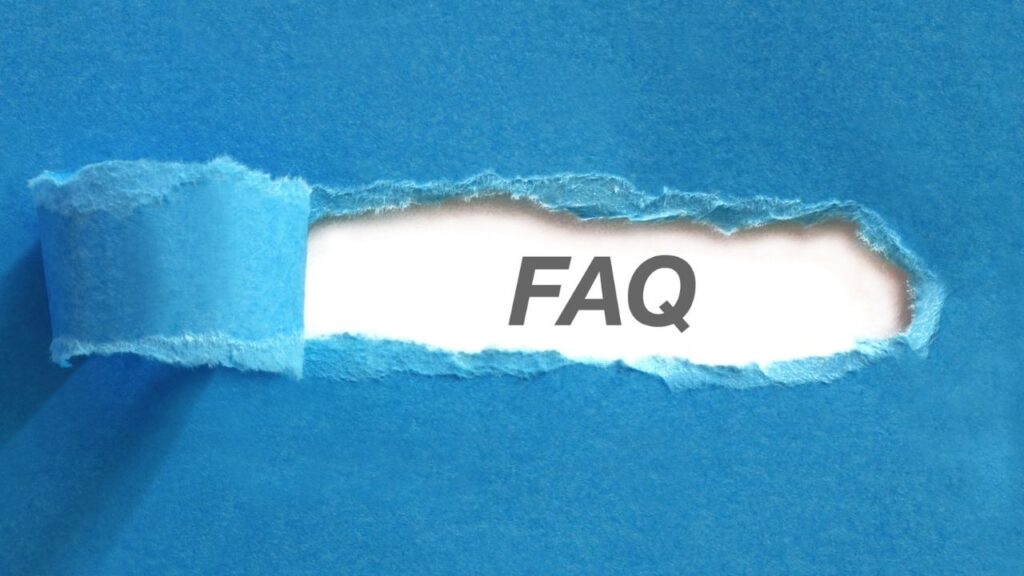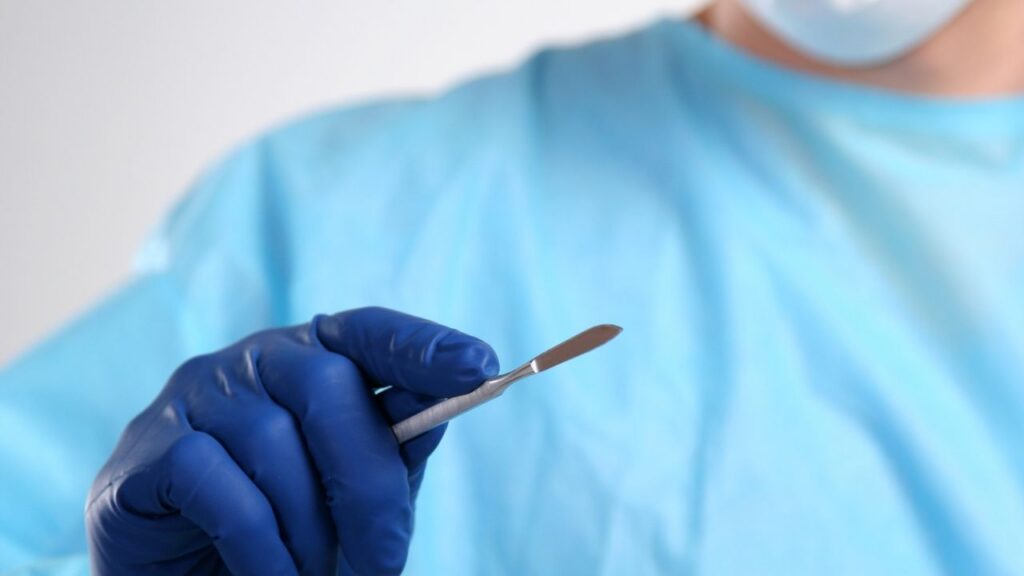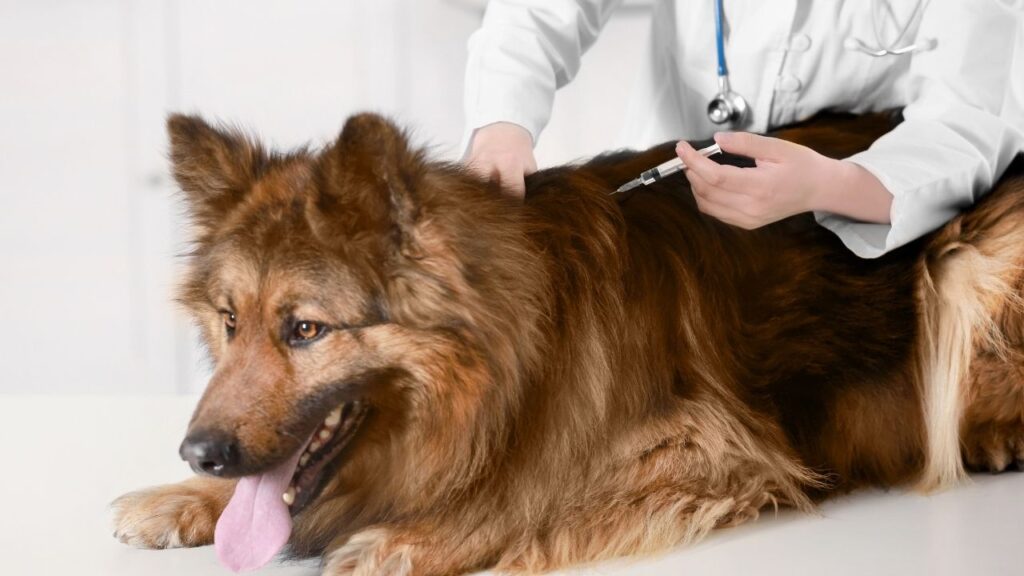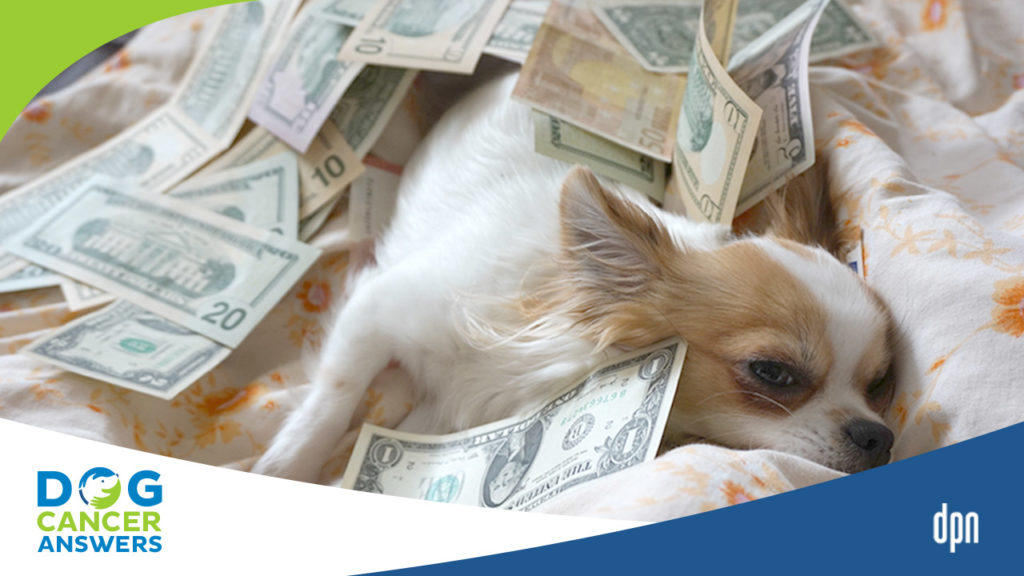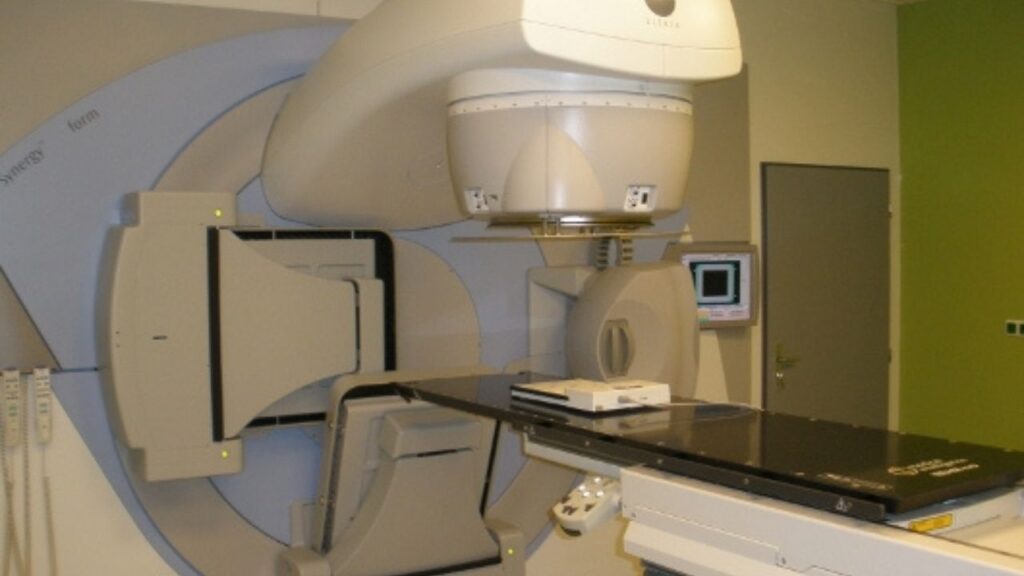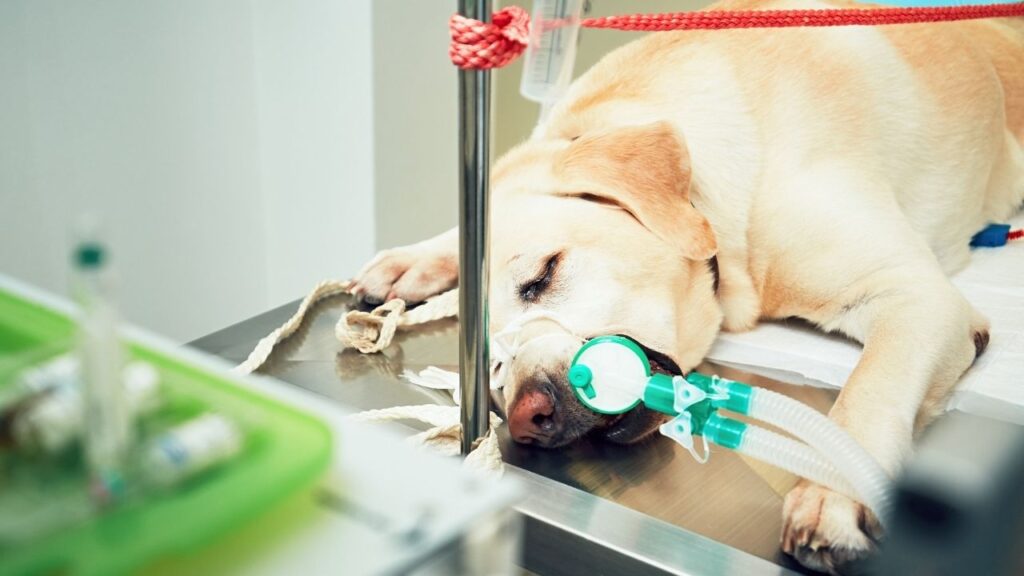Whether your dog is ill, injured, or having a routine yearly wellness exam, your veterinarian will often want to start with blood work. A potential or confirmed cancer diagnosis is no exception. Blood work is common in veterinary medicine, and it provides a lot of very useful information to help your veterinarian make the best decisions for your dog’s care.
Key Takeaways
- Bloodwork is a very important tool for your veterinary team to evaluate your dog’s health and make cancer treatment plans. Bloodwork is almost always recommended.
- Most dogs do not need to be sedated for a blood test, unless they are very afraid or aggressive.
- A CBC (complete blood count) and blood chemistry are the two most common blood panels that most veterinarians will recommend right away for dogs with cancer.
- A CBC (complete blood count) looks at the cells in the blood – red blood cells, white blood cells, and platelets.
- A blood chemistry test looks at the other things in the blood – such as electrolytes, liver enzymes, kidney enzymes, and glucose.
- The cost of blood tests varies widely, based on which test is being ordered. For the basic initial CBC (complete blood count) and blood chemistry, you can expect anywhere from $100 to $300.
- Blood tests give your veterinary team a lot of information, such as how your dog is responding to cancer treatments, how your dog’s organs are functioning, and if your dog’s blood cells are healthy.
When Your Veterinarian Will Recommend Bloodwork
Basic blood work is likely to be recommended at nearly any veterinary appointment, but specific tests will depend on the situation. Here are some common times when blood work is recommended:
- Yearly wellness appointments, especially with older dogs
- Any time your dog is sick
- When diagnosing cancer
- When monitoring cancer treatments and progression
- To help determine if treatments are working and to help plan the next steps
What the veterinarian is looking for will depend on the situation, but here are a few common reasons:
- Evaluate your dog’s health in general
- Monitor or diagnose existing diseases (kidney, liver, heart, endocrine, and others)
- Safety for anesthesia and to guide drug choices, as many dogs will need surgery
- Baseline before starting cancer treatments
- Clues for cancer (see below), looking for paraneoplastic syndromes
Common Examples of Bloodwork in Dogs
What blood tests the veterinarian decides to run can vary widely, based on many factors, including:
- Veterinarian preference
- The available tests
- Symptoms your dog is having
- Other health problems your dog may have
- What type of cancer your dog is suspected to have.
Your veterinarian should be able to explain what each test is and what it is for if you want more details.
As a first diagnostics run, your veterinarian will likely run a panel of basic blood work. There are several values they will look for first:
- Complete blood count (CBC) tests for numbers and abnormal variations of the red blood cells (which carry oxygen to tissues), white blood cells (which are immune system cells that fight disease), and platelets (which form clots to stop bleeding)
- Blood Chemistry Panel tests the “other stuff” in the blood. Specific tests can vary, but most commonly we are looking at electrolytes (minerals in the blood that affect and are affected by nearly every process in the body); liver, kidney, and gall bladder enzymes (show function of these organs); and glucose, among other things.
Your veterinarian may want to run additional specific tests depending on the situation.
Many tests are available, and most of these are not directly related to cancer but may be ordered depending on your dog’s health and other diseases he may already have.
Some specific blood tests you may see include:
- Heartworm test and/or 4DX for heartworm and tick-borne diseases
- Thyroid hormone
- Clotting tests
- Genetic tests
There will likely be other kinds of diagnostic tests in addition to blood work. Other tests that may be recommended include:
- Imaging: x-rays, ultrasound, CT, MRI, echocardiogram, fluoroscopy
- Fine needle aspirate/cytology
- Biopsy
- Fecal tests
- Urinalysis
Your veterinarian might also recommend a liquid biopsy, a relatively new blood work technology that detects circulating tumor DNA in the blood.1 There are many studies currently underway on both dogs and humans, to test its use in the diagnosis, screening, treatment, and recurrence of many cancers.
Veterinary oncologist Dr. Andi Flory discusses OncoK9, the liquid biopsy test.
What Happens When Blood Work is Collected in Dogs
The part of the blood work process that often gives pet guardians the most anxiety is how the blood is collected. Let’s break down what happens “in the back” when we collect blood from a dog.
Why We Take Your Dog Away for Blood Draws
Often, we take dogs to the back treatment area for blood work. There are many reasons for this:
- Sometimes people are nervous about blood and needles.
- Many veterinary technicians like to have extra hands and supplies nearby that may not be in the exam room.
- Many dogs actually do better in the back treatment area, without their guardians. This may be because they sense your anxiety, are trying to defend you, or know if they act upset, you will bail them out.
If you strongly prefer to have your dog’s blood drawn before you, you can let the veterinarian know. But keep in mind, we usually can tell when that’s asking for disaster.
A Gentle Hold
First, your dog must be restrained. This means your dog is being held firmly but gently for her safety and the safety of the assistants and technicians. Usually, it takes one to three handlers, depending on how wiggly and strong your dog is. Most of us put little dogs on the table and big dogs on the floor for the comfort of everyone.
Many dogs do not mind needles but dislike restraint. Any time we can distract them, the blood draw goes much smoother. We use treats — cheese, peanut butter, or whatever your dog likes best — to keep him still and make the experience fun (or at least as nice as possible).
Other methods of distraction include head-tapping, head-scratching, and making silly noises. Some dogs need muzzles for safety, and many dogs are nicely distracted by a muzzle (sometimes, we affectionately call it the “party hat”).
Your dog is babied and cuddled “in the back” and veterinary staff have lots of treats and tricks to help them relax.
Vein Selection
Once your dog is calm and still, the technician drawing the blood will need to find a vein. The technician might shave a tiny spot if the vein is small or hard to see. We often find the vein with some rubbing alcohol added to the area, which also disinfects it.
An assistant — often the same person holding the dog — will “roll” or “hold off” the vein to get it to pop out and be visible to the person drawing the blood.
There are many possible places on a dog’s body to draw blood, but we usually will do one of three:
- The jugular veins are large, and there is one on either side of the neck, right between the muscles in an area called the jugular groove.
- The cephalic veins are relatively large and run right along the top of each front leg.
- The saphenous veins are also relatively large and run at an angle over the outside of each ankle.
Which vein the technician chooses to draw from depends on many factors, including:
- Preference of the person drawing blood
- If a vein needs to be avoided for some reason
- If a vein is hard to see (for example, if your dog is overweight)
- Your dog does not like having his feet touched or people in his face
The Draw
Technicians can draw blood from a vein in several ways, and they will choose the one that works best for them. Often, they need to try multiple times, but the general rule is each technician gets two tries before the next person gets to try.
Some of the types of blood-drawing equipment they may use include:
- A syringe and needle (with a variety of sizes available)
- A butterfly catheter (basically a needle with a little flap and a long tube extension)
- A vacutainer (which uses suction to draw the blood)
- In some hospitalized patients, blood may be drawn from an existing intravenous catheter.
Preparing the Samples
Many blood work tests require a specific additive or handling before being sent to the lab. The technician will put the blood into the required tube, color-coded to show if it contains an anti-coagulant, serum separator, no additives, and so on, and deliver the sample to the pick-up area, machine, or refrigerator immediately.
How Long You Wait for Blood Work Results
The time it takes to get results can vary widely. Some in-house machines get results in minutes, while many send-out lab tests take days or weeks.
A few blood tests have the option of adding on additional tests or reviews that take more time but get more helpful and specific information.
Ask your veterinarian or the technician what to expect so you aren’t waiting anxiously by the phone.
Normal Values for Blood Work in Dogs
Most blood test reports list your dog’s blood test value next to a range of accepted normal values for that test.
Some people see their dog’s lab results and panic when they see abnormalities in the CBC or the chemistry panel. It’s important to understand that a single blood work abnormality doesn’t point to any one cause, or illness.
The numbers on these tests tell a story together, and the lab results need to be evaluated by a veterinarian to give context and meaning.
If you see a value is “out of range” don’t panic. Lab results are read as a whole and in context. One “bad” number does not necessarily mean something is very wrong.
It’s also helpful to know that lab errors happen, and a healthy animal can have a lab result outside the normal reference range.5
In other words, don’t let one abnormal number panic you. It might be within an expected range of error for the lab, it might be just a snapshot in time, or it might only point to a problem if other values are also abnormal.
Reading lab results is a skill veterinarians train for, and it takes both education and experience to fully understand how to read a report.
Your dog’s veterinarian is the best person to help you understand your dog’s blood work results. They will be able to explain every line, and they will also be able to help you understand what values are meaningful, and why.
Understanding Bloodwork in Dogs with Cancer
Can a blood test diagnose cancer in dogs? The answer used to be no; blood work can only provide clues to what might be going on.
Today, the answer is: maybe, and in the future, we hope that turns out to be “yes.”
Liquid biopsy is a new test that shows much promise, but it is still in development. You can ask your veterinarian if it is something he or she has access to or thinks may be appropriate for your dog.1
Blood work tells us about your dog’s general organ health, not necessarily about cancer itself. It offers clues.
Until that perfect cancer blood test is developed, general blood tests – especially a complete blood count and chemistry – are still very helpful, even though they do not directly diagnose cancer. They offer clues about whether your dog has cancer, and what kind of cancer it is.
Sometimes they show us problems that have developed because of cancer, which leads us to the actual cancer diagnosis itself.
Paraneoplastic Syndromes in Dogs
Sometimes cancers cause problems in surrounding or distant tissues that appear on blood work tests, even though we haven’t discovered the actual cancer diagnosis yet.
When an abnormality or health problem shows up in blood tests that is caused by cancer in another part of the body, we call that a “paraneoplastic syndrome.”2
Often the abnormalities your veterinarian looks for on blood work (even just at a general checkup) are related to paraneoplastic syndrome.
Some health issues that show up in routine blood tests can be an early clue that cancer might be present.
Paraneoplastic syndromes that are easy to find can be very handy in helping us catch cancer early in dogs. Some can also help us monitor cancer progression.
Hypercalcemia
A common paraneoplastic syndrome is hypercalcemia – or elevated calcium in the blood. We can detect elevated calcium on a routine chemistry panel.2
Many factors can cause hypercalcemia, including:
- Hormones secreted by the tumor itself
- Abnormalities of calcium absorption by bone, the digestive system, and kidneys
Hypercalcemia does not always mean your dog has cancer – but it is a clue that may help a veterinarian decide to go looking for cancer.
The most common tumors that cause hypercalcemia are anal sac cancer, lymphoma, and multiple myeloma, but many other types of cancer are possible.2
Other Paraneoplastic Syndromes
There are a lot of paraneoplastic syndromes, but not all are as easy to detect as elevated blood calcium. This is a complex area of medicine where veterinarians operate a little like detectives.
Other common examples of paraneoplastic syndromes, which may provide “red flags” or “clues” on blood work include:2
- Multiple myeloma tends to cause high globulin, a protein in the blood.
- Insulinomas will show low blood glucose.
- Mast cell tumors sometimes cause high eosinophils — a type of white blood cell.
- Hemangiosarcoma can cause abnormal red blood cell shape and/or low platelets.3
- Many cancers are associated with anemia — low red blood cells.
- Many cancers, especially lymphoma, are associated with high lymphocytes — a type of white blood cell.
Dr. Lauren Barrow has a unique perspective on cancer treatment and how much it costs. Very helpful!
How Blood Tests are Commonly Used for Cancer
In addition to helping us with clues for diagnosing cancer, blood tests are often used to monitor cancer progression and treatments.
For example, blood work is vital to chemotherapy treatment and monitoring. The blood tests your oncologist runs right before a chemo session help monitor how well your dog is feeling. They are also the most effective way to evaluate your dog’s chemotherapy treatment results.
Your dog’s blood tests in between chemo appointments will help the oncologist with dose and drug choice.
Blood test results can be affected by both the chemotherapy drug and the cancer itself.4 Your veterinarian or oncologist will use the lab results to decide whether to change the dose, switch to a new agent, or stop chemotherapy altogether.
Without routine blood work during chemotherapy, your veterinarian is “flying blind.”
Frequently Asked Questions About Blood Work in Dogs with Cancer
Let’s get some common questions answered.
Q: Why check a complete blood count (CBC)?
A: Decreased function of bone marrow is very common with most chemotherapy drugs. Since red blood cells, white blood cells, and platelets are made in the bone marrow, a complete blood count is a handy way to monitor those drugs.
A common method is to check a complete blood count (CBC) every one to two weeks, then monthly if things are going well, and more often if there are changes.4
White Blood Cells
Nearly every chemotherapy drug causes neutropenia – a decrease in a specific type of white blood cell called a neutrophil. Also, if neutrophils are too low, there is a larger risk of infection. Knowing these numbers helps guide when to slow down, stop, take a break, or switch chemotherapy drugs.4
Platelets
Low platelets are commonly seen in dogs with cancer.4 The most common cancers that cause low platelets are leukemia, lymphoma, multiple myeloma, mast cell disease, histiocytic sarcoma, and hemangiosarcoma. The most common chemotherapy drug that causes low platelets is CCNU (lomustine).4
Red Blood Cells
Decreased red blood cells (anemia) are common and are worth monitoring as anemic patients generally have a worse outcome. In general, anemia happens with the same types of cancers as thrombocytopenia.4
Blood Smear
In addition to cell counts, a smear can provide much information. A smear – a peripheral blood film or manual differential – is a thin film of blood cells on a slide, evaluated through a microscope.
The technician or doctor is looking for abnormal shapes, numbers, and/or clumping of cells. Up to 20% of cancer patients have an abnormality on the smear that could potentially change the treatment plan.4
Q: Why check blood chemistry?
A: Blood chemistry helps tell us how well your dog’s organs function. Chemotherapy is meant to kill cancer cells, but it can also damage healthy normal cells.
Any problems with your dog’s functional organs need to be caught as early as possible to adjust the treatment plan, which is why a blood chemistry panel is run routinely if your dog is on medications or undergoing treatments that could damage the internal organs.
Kidney Function
Dogs with kidney disease are generally more susceptible to infection, so it’s important to monitor their health while your dog is being treated for cancer. But even if your dog’s kidneys are otherwise healthy, monitoring their health during cancer treatments is good. That’s because the kidneys are essential to several bodily functions, including:
- maintaining water balance
- controlling blood pressure
- removing toxins
- balancing electrolytes
Several values on a standard blood panel — usually along with a urinalysis — can help evaluate how your dog’s kidneys are functioning.
More specific reasons for kidney monitoring depend on the type of cancer and chemotherapy. For example, increased BUN without creatinine (two common kidney tests) can indicate bleeding in the gastrointestinal tract.
Some chemotherapies are known kidney toxins: cisplatin, carboplatin, and possibly doxorubicin. And some cancers, such as bladder and prostate cancer, can actually alter the shape and function of organs in the urinary tract.4
Liver Function
The liver is a complicated organ and is essential to a variety of bodily functions, including:
- digestion
- filtration of waste
- metabolism
- storage of vitamins and minerals
- protein synthesis
Many chemotherapy drugs are processed by the liver (such as doxorubicin, vincristine, and vinblastine), and a few others can be toxic to the liver (such as CCNU or lumustine). Liver toxicity can be fatal if not treated.4
An increase in liver enzymes (especially ALT, ALP, and GGT), and/or bilirubin, can mean inflammation and damage to the liver cells.
Other values, such as glucose, albumin, BUN, and cholesterol, are known as “Pseudofunction tests.” These tests also help indicate how well the liver functions and are often low in dogs with primary or metastatic liver tumors.4
When the liver function tests are abnormal, your veterinarian may recommend either discontinuing or adjusting the chemotherapy plan. Many veterinarians will also recommend a liver supplement such as Denamarin.
Electrolytes
Electrolytes are minerals in the body that carry an electric charge and are essential to cell function. Even minor imbalances can cause major problems with hydration, acid/base balance, nerve, and muscle function.
When your veterinarian finds electrolyte abnormalities, he or she can adjust medications and supplements to correct them quickly.
Acute Tumor Lysis Syndrome
Acute tumor lysis syndrome is a specific condition associated with the sudden cell death of lymphoma cells. It usually happens one to two days after your dog first starts chemotherapy.
When the cells die, they release their contents, causing the bloodwork to show abnormal electrolytes such as high phosphate, high potassium, low calcium, and metabolic acidosis.
Our goal in chemotherapy is to kill lots of lymphoma. Still, when too much tumor death happens at one time, all those excess electrolytes and metabolites from the dying and dead cancer cells can overwhelm the body’s systems. Acute tumor lysis syndrome must be caught early, or it can lead to kidney failure and death.4
Q: What are they looking for during radiation, before surgery, or during immunotherapy?
If your dog is having surgery, or getting immunotherapy treatments, your veterinarian will likely still want to check blood work periodically, to monitor your dog’s general health.
Usually, response to radiation is measured by other methods, such as clinical signs and imaging.
Q: What are veterinarians looking for during palliative care?
When the goal of treatment is maintaining your dog’s comfort and quality of life, we often use signs, symptoms, and your dog’s behavior to adjust the treatment plan.
Mostly we want to know how your dog is feeling, if he’s eating, if he wants to go on walks, and that kind of thing. Blood work can be helpful in monitoring his health in general.
It can also be helpful to know if his organs are beginning to fail and to evaluate the safety of certain medications so that you can make decisions in his care.
How to Get the Best Blood Work Results
Most of the time, not much preparation is needed before a blood draw. The best thing you can do is help keep your dog calm at the veterinarian’s office.
Most of the time, fasting is not required, but your veterinarian should let you know beforehand. If your dog is on any medications, supplements, or special diets, let the vet know because some can affect lab results.
Home Care After Blood Collection
In general, not much home care is required after a blood draw.
If there’s a bandage, take it off an hour or two after you get home.
Most dogs don’t react to blood draws and have no reaction to it later on.
If the area bleeds, don’t panic, but put gentle pressure on it and call the veterinarian if the bleeding doesn’t stop in a few minutes.
Bruising is common, especially in thin-skinned or older dogs, as are hematomas, which is a swelling over the area full of blood. These will resolve over time.
Some dogs are itchy where blood was drawn — especially if the area was shaved — so don’t let your dog lick it.
Follow-Up Blood Tests in Dogs with Cancer
Your veterinarian will often want to run the same test more than once, looking for patterns. Sometimes a basic blood test will lead to a different follow-up test. Your veterinarian is looking for more information to help decide if your dog’s treatment is working, or if they need to adjust the plan.
When to Not Run Bloodwork
We may not want to check blood work in a few situations.
If there is no medical reason for blood work, or it is not in the budget, your veterinarian may propose an alternative or abbreviated plan.
Some dogs are too afraid or too aggressive to restrain safely. These dogs will often get sedation so that we can get blood drawn (if blood work is that important).
Veterinarians will proceed with caution if a dog has bleeding issues.
Where to Get Bloodwork for Your Dog
Many routine blood tests can be done at your regular veterinarian, but some oncologists will recommend more specific tests.
Since many tests will need to be repeated at specific intervals, your regular veterinarian and oncologist may be able to work together to keep costs down, for example, by having your veterinarian run the tests, rather than your oncologist.
Ask your veterinarian and oncologist to work together if you have more specific questions. We are a collaborative bunch and want what is best for your dog.
Veterinary oncologist Dr. Megan Duffy discusses the common costs associated with treating dog cancer.
Safety and Side Effects of Bloodwork in Dogs
Blood work is generally safe.
Monitor the blood draw site for bleeding, bruises, and hematomas, especially if your dog has clotting problems. If you see anything concerning, call your veterinarian for advice.
Cost of Bloodwork in Dogs with Cancer
Costs of blood work can vary widely based on many factors, including:
- location, or area where you live
- if it was done at the regular veterinary office versus a specialist
- if the labs were run in-house versus sent out
- which tests are included in the panel
A basic CBC/chemistry will likely cost $100-300.
More specific tests can run anywhere from $50 to $600 and more.
Blood work, lab tests, and diagnostics are often a large part of a cancer treatment protocol.
Many of these tests are recurring, so they can add up quickly; so if budget is a concern, be sure to let your veterinarian know that so they can recommend “good, better, and best” options.
Topics
Did You Find This Helpful? Share It with Your Pack!
Use the buttons to share what you learned on social media, download a PDF, print this out, or email it to your veterinarian.
